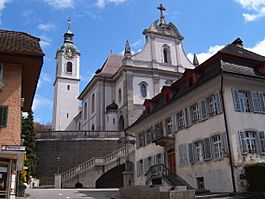Hitzkirch facts for kids
Quick facts for kids
Hitzkirch
|
||
|---|---|---|
 |
||
|
||
| Country | Switzerland | |
| Canton | Lucerne | |
| District | Hochdorf | |
| Area | ||
| • Total | 27.61 km2 (10.66 sq mi) | |
| Elevation | 498 m (1,634 ft) | |
| Population
(Dec 2020 )
|
||
| • Total | 5,455 | |
| • Density | 197.57/km2 (511.71/sq mi) | |
| Postal code |
6285
|
|
| Surrounded by | Altwis, Ermensee, Gelfingen, Hämikon, Retschwil, Römerswil, Sulz | |
Hitzkirch is a town, also called a municipality, located in the canton of Lucerne in Switzerland. It is part of the Hochdorf district. Over the years, Hitzkirch has grown by joining with nearby towns. On January 1, 2009, the towns of Gelfingen, Hämikon, Mosen, Müswangen, Retschwil, and Sulz became part of Hitzkirch. Later, on January 1, 2021, Altwis also merged into Hitzkirch.
Contents
History of Hitzkirch
Hitzkirch is an old town with a long history. It was first mentioned in official records way back in 1230. Back then, its name was written as Hiltschilche.
Altwis: A Part of Hitzkirch's Past
The town of Altwis, which is now part of Hitzkirch, also has a long history. It was first mentioned even earlier, in 1113. Its name was written as Altwise at that time.
Geography of Hitzkirch
Hitzkirch is nestled in a beautiful area called the Seetal valley. It sits right at the base of the Lindenberg mountain.
After the town of Altwis joined in 2021, Hitzkirch became larger. About 66% of its land is used for farming. This means there are many fields and pastures. Another 14% of the land is covered by forests. The remaining land includes buildings, roads, and a small part with rivers or other natural features.
In 2006, there was an idea to combine Hitzkirch with 10 other towns nearby. However, this plan didn't work out because five of the towns voted against it. So, a smaller plan was made. This new plan was accepted, and that's how Gelfingen, Hämikon, Mosen, Müswangen, Retschwil, and Sulz joined Hitzkirch.
People and Life in Hitzkirch
Hitzkirch is home to many people. As of the latest count, Hitzkirch has a population of 5,455 residents. About 18.9% of the people living in Hitzkirch are from other countries. When you include all the towns that merged into Hitzkirch, the total population is 4,588 people.
Most people in Hitzkirch speak German, which is about 87.8% of the population. Albanian is the second most common language, spoken by 4.3% of residents. Serbo-Croatian is the third most common, spoken by 3.3%.
Education and Homes in Hitzkirch
People in Switzerland are generally well-educated. In Hitzkirch, about 68.5% of adults aged 25 to 64 have finished high school or gone on to higher education, like university.
In 2000, there were 1,503 homes in Hitzkirch. About 23.1% of these homes had only one person living in them. On the other hand, about 15.2% were large homes with five or more people. Most of the homes in Hitzkirch are either two or three stories tall.
Jobs and Work in Hitzkirch
Hitzkirch has a low unemployment rate, which means most people who want to work can find jobs. About 1.79% of people are looking for work.
Jobs in Hitzkirch are divided into three main types:
- Primary sector: This includes jobs like farming. About 44 people work in this area.
- Secondary sector: These are jobs in factories or construction. About 786 people work here.
- Tertiary sector: This includes jobs in services, like shops, offices, and healthcare. About 680 people work in this sector.
In 2000, about 50.9% of the people in Hitzkirch had a job. Also, women made up 42% of the people working.
Religions in Hitzkirch
In 2000, most people in Hitzkirch were Roman Catholic, making up about 74.6% of the population. About 10% were Protestant. Other Christian faiths made up 1.85%. There were also people who were Muslim (5.22%) and a small number who were Jewish. Some people belonged to other religions, and some did not follow any organized religion.
Population Changes Over Time
The chart below shows how the population of Hitzkirch and Altwis has changed throughout history. You can see how the number of people living in these towns has grown or shrunk over the years.

Hitzkirch's World Heritage Site
Hitzkirch is special because it is home to the Seematte prehistoric pile-dwelling settlements. These are ancient villages built on stilts over water. They are part of the Prehistoric Pile dwellings around the Alps which is a UNESCO World Heritage Site. This means they are very important historical sites recognized by the United Nations.
The Seematte area was once home to several ancient settlements. These were built by different groups of people during the Neolithic period, also known as the New Stone Age. These groups included the Cortaillod, Pfyn, Horgen, and Corded Ware cultures.
The site stretches for about 400 meters (1,312 feet) along the northern end of Lake Baldegg. These ancient remains were first found in 1860. More digging happened in 1871 and 1922. In 1938, about 600 square meters (6,458 square feet) were excavated. During these digs, archaeologists found two layers of settlements from the Cortaillod culture. They also found many interesting items made of ceramic, stone, flint, bone, and antler. These items tell us a lot about how people lived thousands of years ago.
See also
 In Spanish: Hitzkirch para niños
In Spanish: Hitzkirch para niños





